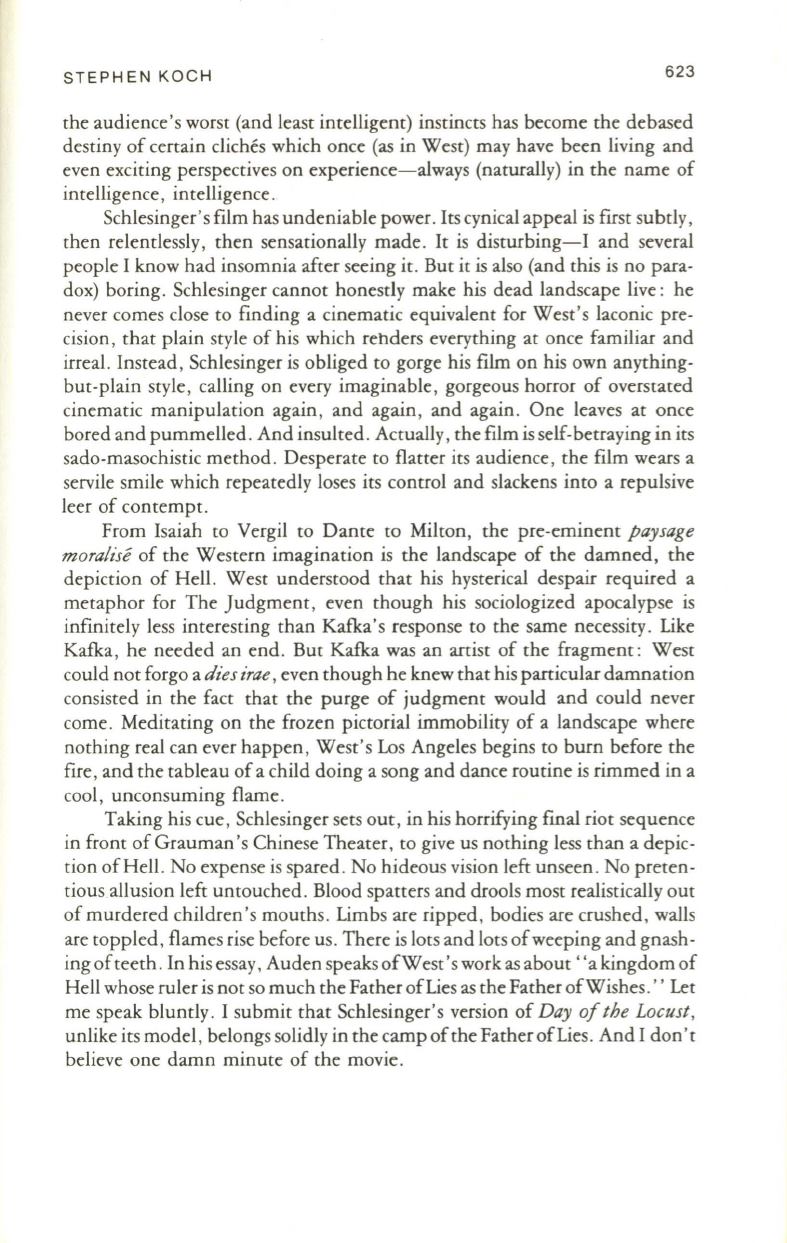
STEPHEN KOCH
623
the audience's worst (and least intelligent) instincts has become the debased
destiny of certain cliches which once (as in West) may have been living and
even exciting perspectives on experience-always (naturally) in the name of
intelligence, intelligence .
Schlesinger's film has undeniable power. Its cynical appeal is first subtly,
then relentlessly, then sensationally made. It is disturbing-I and several
people I know had insomnia after seeing it. But it is also (and this is no para–
dox) boring . Schlesinger cannot honestly make his dead landscape live : he
never comes close to finding a cinematic equivalent for West's laconic pre–
cision , that plain style of his which rehders everything at once familiar and
irreal. Instead, Schlesinger is obliged to gorge his film on his own anything–
but-plain style, calling on every imaginable, gorgeous horror of overstated
cinematic manipulation again, and again , and again . One leaves at once
bored and pummelled . And insulted. Actually, the film is self- betraying in its
sado-masochistic method. Desperate to flatter its audience, the film wears a
servile smile which repeatedly loses its control and slackens into a repulsive
leer of contempt.
From Isaiah to Vergil to Dante to Milton, the pre-eminent
paysage
mora/ise
of the Western imagination is the landscape of the damned, the
depiction of Hell. West understood that his hysterical despair required a
metaphor for The Judgment, even though his sociologized apocalypse is
infinitely less interesting than Kafka's response to the same necessity. Like
Kafka , he needed an end . But Kafka was an artist of the fragment : West
could not forgo a
dies irae
,
even though he knew that his particular damnation
consisted in the fact that the purge of judgment would and could never
come . Meditating on the frozen pictorial immobility of a landscape where
nothing real can ever happen, West's Los Angeles begins to burn before the
fire , and the tableau of a child doing a song and dance routine is rimmed in a
cool, unconsuming flame .
Taking his cue, Schlesinger sets out, in his horrifying final riot sequence
in front of Grauman 's Chinese Theater, to give us nothing less than a depic–
tion ofHell . No expense is spared . No hideous vision left unseen . No preten–
tious.allusion left untouched . Blood spatters and drools most realistically out
of murdered children 's mouths . Limbs are ripped , bodies are crushed, walls
are toppled, flames rise before us . There is lots and lots ofweeping and gnash–
ing ofteeth. In his essay , Auden speaks ofWest 'swork as about" a kingdom of
Hell whose ruler is not so much the Father ofLies as the Father ofWishes." Let
me speak bluntly . I submit that Schlesinger's version of
Day of the Locust,
unlike its model , belongs solidly in the camp of the FatherofLies . And I don't
believe one damn minute of the movie.


